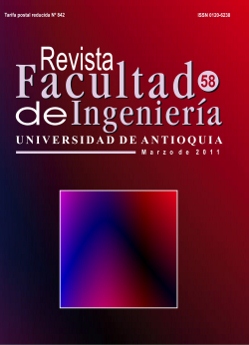Comparative analysis of PM10 particulate matter
DOI:
https://doi.org/10.17533/udea.redin.14596Keywords:
particles, sampling, humidity, concentration, regressionAbstract
This paper presents the concentrations of PM10 in the urban area of Riohacha, Colombia. Two simultaneous sampling methods are compared. The high-volume sampler PM10, Graseby Andersen and a nephelometer DataRam 4 (Thermo Electron corporation). Data was collected over three months in two sites (Desalud and Bienestar) of the urban area of Riohacha. The results show that the average PM10 concentration was 23.64 μg/m3 and 36.86 μg/m3 in the two stations using the DataRam 4 and 25.09 μg/m3 and 36.64 μg/m3 using the high-volume sampler PM10. The correlation analysis shows a positive consistency for all the pairs in these two monitoring methods: R2 = 0.5377 for the season Desalud and R2 = 0.7276 for the season Bienestar. The coeffi cient increased when the results were correlated to the days with RH less than 70%: R2 = 0.89 station Desalud and R2 = 0.69 Bienestar Station. The results showed that the photometric method (DataRam 4) can be used to determine concentrations of particulate matter PM10 at Riohacha environmental conditions.
Downloads
References
M. J. Nieuwenhuijsen, J. E. Gómez-Perales, R. N. Colvile. “Levels of particulate air pollution, its elemental composition, determinants and health effects in metro systems”. Atmospheric Environment. Vol. 41. 2007. pp. 7995 8006. DOI: https://doi.org/10.1016/j.atmosenv.2007.08.002
B. Brunekreef, S. T. Holgate. “Air pollution and health”. The Lancet. Vol. 360. 2002. pp 1233-1342. DOI: https://doi.org/10.1016/S0140-6736(02)11274-8
C. A. Pope 3rd, D. W. Dockery.” Health effects of fi ne particulate air pollution: lines that connect”. Journal of the Air and Waste Management Association. Vol. 56. 2006. pp. 1368-1380. DOI: https://doi.org/10.1080/10473289.2006.10464545
J. M. Vallius, J. Ruskannen, A. Mirme, J. Pekkanen. “Concentrations and Estimated Soot Content of PM1, PM2.5, and PM10 in a Subarctic Urban Atmosphere”. Environmental Science & Technology. Vol. 34. 2000. pp. 1919-1925. DOI: https://doi.org/10.1021/es990603e
S. Lu, Q. Luan, Z. Jiao, M. Wu, Z. Li, L. Shao, F. Wang. “Mineralogy of Inhalable Particulate Matter (PM10), in the Atmosphere of Beijing, China”. Journal Water Air Soil Pollution. Vol. 186. 2007. pp. 129-137. DOI: https://doi.org/10.1007/s11270-007-9470-5
E. Kainka, G. Kramert , J. Dudzeviciusij. “Characterisation of particulate matter PM10 and PM2.5 in northrhine westphalia, saxonia and lithuania-fi rst results”. British Occupational Hygiene Society. Vol. 41. 1997. pp. 54-59.
R. Rojano, D. Soto, Y. Mendoza, A. Alvarado, E. Gámez. Determinación de la concentración de partículas suspendidas totales (PST), en la zona urbana de la ciudad de Riohacha, La Guajira colombiana Universidad de La Guajira. Centro de Investigación. Facultad de Ingeniería. Colombia 2007. pp. 92- 93.
T. William, J. Winberry Jr. Compendium Method IO- 2.1. Sampling of ambient air for Total Suspended Particulate Matter (SPM) and PM10 using high volume (HV) sampler. Center for Environmental Research Information Offi ce of Research and Development U.S. EPA Cincinnati. 1999. pp.26-38.
A. Trent, M. A. Davies, R. Fisher, H. Thistle, R. Babbitt. Evaluation of optical instruments for real-time continuous monitoring of smoke particles. Department of Agriculture Forest Service. Missoula. Montana. Technology and Development Program. 2000. pp.5-14.
J. G. Watson, J. C. Chow, H. Moosmüller, M. Green, N. Frank, M. Pitchford. Guidance for using continuous monitors in PM2.5 monitoring networks. Environmental Protection Agency. North Carolina. 1998. pp. 36-52.
L. Cabeza Durango. Climatología de los principales puertos del Caribe Colombiano. Centro de Investigaciones Oceanográfi cas e Hidrográfi cas. Cartagena de Indias. D.T. Boletín Científi co CIOH. 2009. pp. 4-10.
S. S. Pérez. Resolución 0601 de abril 4 de 2006. Ministerio de ambiente. Vivienda y desarrollo territorial. Bogotá D.C. 2006. pp. 6-9.
D. E. King. Evaluation of interlaboratory comparison data on linear regression analysis. In Methods and Standards for Environmental Measurement. W. H. Kirchoff. (editor). NBS Publication. Gaithersburg. 1977. pp. 581-596.
P. H. Mc Murry “A review of atmospheric aerosol measurements”. Atmospheric Environment. Vol. 30. 2000. pp. 1959-1999. DOI: https://doi.org/10.1016/S1352-2310(99)00455-0
S. Shen, P. A. Jaques, Y. Zhu, M. D. Geller, C. Sioutas. “Evaluation of the SMPS–APS system as a continuous monitor for measuring PM2.5, PM10 and coarse (PM2.5_10) concentrations”. Atmospheric Environment. Vol. 30. 2002. pp. 1959-1999. DOI: https://doi.org/10.1016/S1352-2310(02)00330-8
C. Sioutas, S. Kim, M. C. Chang, L. Terrell, H. Gong 2000. “Field evaluation of a modifi ed DataRAM Mie scattering monitor for real-time PM2.5 mass concentration measurements”. Atmospheric Environment. Vol. 34. pp. 4829-4838. DOI: https://doi.org/10.1016/S1352-2310(00)00244-2
Downloads
Published
How to Cite
Issue
Section
License
Copyright (c) 2018 Revista Facultad de Ingeniería

This work is licensed under a Creative Commons Attribution-NonCommercial-ShareAlike 4.0 International License.
Revista Facultad de Ingeniería, Universidad de Antioquia is licensed under the Creative Commons Attribution BY-NC-SA 4.0 license. https://creativecommons.org/licenses/by-nc-sa/4.0/deed.en
You are free to:
Share — copy and redistribute the material in any medium or format
Adapt — remix, transform, and build upon the material
Under the following terms:
Attribution — You must give appropriate credit, provide a link to the license, and indicate if changes were made. You may do so in any reasonable manner, but not in any way that suggests the licensor endorses you or your use.
NonCommercial — You may not use the material for commercial purposes.
ShareAlike — If you remix, transform, or build upon the material, you must distribute your contributions under the same license as the original.
The material published in the journal can be distributed, copied and exhibited by third parties if the respective credits are given to the journal. No commercial benefit can be obtained and derivative works must be under the same license terms as the original work.










 Twitter
Twitter